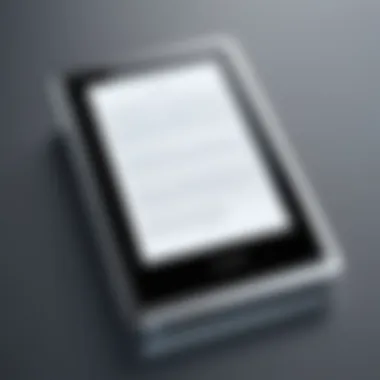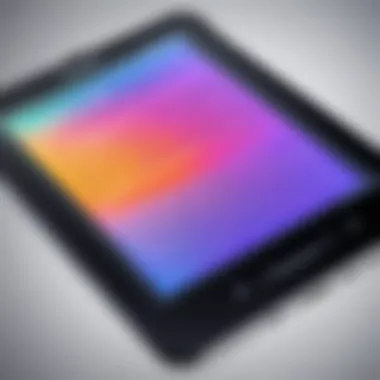Top E-Readers Reviewed: Choose Your Perfect Device


Intro
In an era overflowing with digital content and endless distractions, e-readers have emerged as a beacon for avid readers. These devices seamlessly blend technology with the timeless joy of reading. They offer a portable library at your fingertips, allowing you to carry thousands of books wherever you go without the bulk of traditional paperbacks.
As technology evolves, so do the capabilities and features of e-readers. What was once a simple device for reading is now more akin to a multifunctional tool. Whether you're digesting the latest bestseller or diving into a hefty academic tome, the way these devices cater to varied reading preferences is noteworthy. Coupled with the rise of independent publishing and digital libraries, understanding the landscape of e-readers has never been more important.
This guide embarks on a deep dive into the world of e-readers, dissecting prominent devices currently dominating the market. A thorough analysis of technical specifications, user interfaces, and design principles will equip you with a clearer understanding of each device’s selling propositions. We’ll also discuss pertinent factors to consider when investing in an e-reader, providing comparisons among leading models. As we analyze these elements, we will take a peek into the future of e-reading technology and what innovations might be just on the horizon.
Through this exploration, our goal is to empower tech-savvy individuals and gadget enthusiasts alike. The insights gleaned from this guide will help navigate the digital reading device spectrum, fostering informed choices that align with individual reading habits and lifestyles.
Prelude to E-Readers
The realm of digital reading has undergone a remarkable transformation over the years, with e-readers emerging as integral devices for book lovers. The importance of understanding e-readers cannot be overstated, especially in an age where physical books often compete with their digital counterparts. This section aims to shed light on what e-readers are and why they have become prevalent within various demographics.
An e-reader is a portable electronic device designed primarily for reading e-books and periodicals. E-readers offer numerous benefits when compared to traditional reading methods. For one, they can store a vast library of literature without occupying physical space, a noteworthy asset for avid readers lacking shelf space. Moreover, features like adjustable font sizes and brightness settings provide a reading experience tailored for individual preferences, reducing eye strain during prolonged use.
But it’s also about convenience—having access to countless titles in just a few taps can be a real game changer. From students needing many textbooks to travelers wanting to enjoy novels without the hassle of carrying multiple books, e-readers cater to diverse reading habits.
When considering a digital reading device, it's crucial to evaluate not just the initial purchase price but also factors such as durability, battery life, and the ecosystem it operates in, as each of these aspects contributes to an overall user experience.
"The early bird may catch the worm, but the second mouse gets the cheese." Such wisdom applies to the e-reading world, too; careful consideration leads to the best choices.
In summary, this section of the article serves as a gateway to understanding e-readers better, unveiling their definitions, purposes, and specifying why they hold significant value in today’s literary landscape.
The Evolution of E-Readers
The journey of e-readers has been nothing short of fascinating, reflecting the rapid advancements in technology and the nuanced needs of readers. To comprehend the significance of e-readers today, it helps to trace their evolution from humble beginnings to the sophisticated devices we see now. In this section, we will unravel this transformative timeline, highlighting crucial milestones, revolutionary innovations, and the transformative impact these devices have had on digital reading.
When e-readers first emerged on the scene, they were fairly rudimentary. Devices like the Rocket eBook and SoftBook, introduced in the late 1990s, paved the way for more advanced models. These early gadgets had limited functionality and display capabilities, often resembling oversized calculators more than modern e-readers. Nevertheless, they were a significant leap toward digitizing literature, offering a precursor to the reading experiences that would later flourish.
From Early Models to Modern Innovations
In the noughties, the introduction of the Amazon Kindle in 2007 marked a turning point. This sleek device enabled users to access a massive library of books digitally, integrating online purchasing directly into the reading experience. Suddenly, the idea of carrying an entire library in your pocket was not just a dream; it became a reality, significantly altering how people interacted with books.
Key Transformations in E-Reader Technology:
- E-Ink Displays: Early e-readers often faced challenges with glare and battery life. The development of e-ink technology finally created displays that simulated the look of paper, making reading much more comfortable in various lighting conditions.
- Connectivity Options: The shift from offline reading to the ability to download books seamlessly marked a dramatic shift in usability. Wi-Fi and, later, cellular capabilities meant readers could access new titles any time, any place.
- Ecosystems and Integrated Services: Major brands began building their own ecosystems. Amazon, for instance, linked Kindle devices to their online store, allowing users to download, review, and sync books across devices. This created a comprehensive reading environment that encouraged loyalty.


"E-readers have not just changed how we read; they have redefined our relationship with books, making reading a dynamic experience"
Tying in this evolution are the numerous benefits that these devices brought to avid readers. Convenience tops the list; the lightweight design and portability mean they can be easily carried around, unlike traditional books. Furthermore, e-readers have enhanced accessibility for many, featuring adjustable fonts and background colors that cater to readers with visual impairments.
As we delved into this era of e-readers, one must not ignore the environmental impact. Each paper book produced comes at a cost to nature, while e-readers, though relying on technology, don’t have the same level of resource depletion connected to traditional publishing. Yet, there's an ongoing debate about electronic waste that new initiatives are attempting to address.
Thus, the narrative surrounding e-readers is complex, evolving from basic electronic devices to advanced, multifunctional tools. The blend of technology with literature continues to influence reading habits and expectations, setting the stage for future innovations. Readers today demand not just new titles but a complete ecosystem that enhances their engagement with content, signifying that the evolution of e-readers will keep pacing forward, catering to the ever-changing landscape of media consumption.
Criteria for Evaluating E-Readers
When navigating the vast sea of e-readers available today, establishing a solid set of criteria is paramount. The right e-reader can significantly enhance one’s reading experience, making it akin to the difference between reading a dog-eared paperback and a freshly printed hardcover. The world of digital reading devices has advanced quite a bit, and potential buyers should know what elements come into play before committing their hard-earned cash.
Understanding the criteria for evaluation ensures that readers choose a device that aligns perfectly with their reading habits, preferences, and goals.
Screen Technology and Display Quality
The heart of any e-reader lies in its display. Picture this: you’re engrossed in a gripping novel, and then your eyes start to ache. Flickering screens or poor contrast can ruin the experience faster than a flat battery. E-readers typically use e-ink technology, designed to mimic the look of paper, providing a more comfortable reading experience. The quality of this technology varies, so potential buyers should consider the resolution and brightness. Higher resolution displays not only permit clearer text but also enhance the ability to read in different lighting conditions.
Additionally, adjustability in screen light plays a crucial role. You might love reading at bedtime, and having a built-in frontlight with adjustable warmth can truly make a difference. Familiarize yourself with the specifications related to screen size and touch responsiveness—after all, no one wants to struggle with page-turning in the middle of an exciting chapter.
Battery Life and Charging Solutions
Now, think about a scenario: you’re on an extended trip, far from chargers or the comfort of your home. An e-reader that dies prematurely can leave you longing for more pages, much like a hunter without a rifle. Battery life is often advertised in weeks rather than hours, which is a testament to how efficient many e-readers are. Most can last through thousands of page turns before needing a charge, making them perfect travel companions.
Moreover, consider the charging solutions. Proprietary chargers can be a hassle if you lose yours, while device compatibility with USB-C or micro USB can add convenience. Evaluating the device's charging speed is also essential; some models might boast fast charging capabilities—an attractive feature when you’re pressed for time.
Storage Capacity and Format Support
Imagine busting your budget and bringing home an e-reader only to discover it can barely hold a fraction of your cherished library. It’s like buying a suitcase that can't fit your clothes. Storage capacity is vital, especially for voracious readers. Many e-readers come with internal storage ranging from 8GB to 32GB. This feature is critical for those who prefer to keep extensive libraries on-hand. Furthermore, check for format support, as compatibility with popular formats like EPUB, MOBI, or PDF can make or break your experience.
User Interface and Usability
Lastly, let’s talk about user interface and usability. An e-reader is designed to facilitate reading, so any clunky interface can quickly become a dealbreaker. Consider how intuitive the layout is, the simplicity of navigating through menus, and whether the screen offers touch functionality or physical buttons. The responsiveness of these elements can create a more enjoyable reading experience overall. Evaluate whether the e-reader supports features such as font adjustments, bookmarks, and notes. A null option in these areas may feel like trying to read without your glasses.
Overview of the Top E-Readers
When one begins to navigate the landscape of digital reading devices, it soon becomes abundantly clear that not all e-readers are crafted equally. The significance of this section cannot be overstated; it serves as the compass guiding prospective buyers through a sea of options. Understanding the unique features and attributes that define the top e-readers is crucial for making an informed decision.
Recognizing the distinct offerings of devices like Kindle Oasis and Kobo Clara HD enhances the reader's experience. Each e-reader presents its own strengths, attributes, and potential weaknesses that cater to varying needs. In an age where convenience and accessibility are paramount, a thorough examination of these devices helps to illuminate the best choices for every kind of reader.


The emphasis on this overview is not merely to list devices but rather to contextualize their relevance in the broader panorama of digital reading. E-readers nowadays are not just passive containers of books but active tools that enrich our reading experience through features like illuminated displays, waterproof designs, extensive battery life, and optimized user interfaces.
"Reading is not just about the text; it's about the experience. E-readers have transformed how we engage with literature."
This section elaborates on what makes each leading device stand out. It addresses essential elements, lifestyle considerations, and what readers can genuinely expect from their investment. Whether you're a casual reader, a tech enthusiast, or someone who finds solace in exploring vast literary worlds, this guide elucidates the paths available for your digital reading journey.
Comparative Analysis of E-Readers
When it comes to selecting an e-reader, a comparative analysis serves as a crucial tool. This section of the guide sheds light on the critical aspect of reviewing e-readers side by side. By focusing on distinct features, performance metrics, and user experiences, readers can make informed choices that cater to their specific needs.
Understanding how e-readers stack up against each other allows potential buyers to pinpoint what truly matters. Some folks might prioritize screen quality for comfortable long reads, while others could be more inclined towards extensive storage capabilities or battery longevity. This analysis is essential for a few key reasons:
- Smart Choices: With several models on the market, determining which device aligns with personal reading habits can save time and money.
- Saves the Headache: Comparing features such as display resolution, weight, and waterproof capabilities simplifies decision-making.
- Reduces Regret: Knowing the pros and cons of various options can lead to a selection that feels right rather than second-guessing down the line.
Feature-by-Feature Breakdown
A feature-by-feature breakdown is the backbone of any comparative analysis. It provides granular insight into what each e-reader brings to the table, highlighting strengths and weaknesses that may not be immediately apparent. Here are some critical elements to consider:
- Screen Technology: Look at whether the device uses E Ink or LCD displays. E Ink displays are easier on the eyes and read better in daylight, which is ideal for outdoor reading enthusiasts.
- User Interface: Consider how intuitive the controls are. An overly complicated menu can be a real pain when just trying to dive into a book.
- Connectivity Options: Wi-Fi or cellular? For those who like their books loaded up and ready to go, this aspect can be a game-changer.
- Supported Formats: Not all devices support the same e-book formats. Users should check compatibility with their existing library to avoid any hiccups later.
- Weight and Portability: For avid readers on the go, a lighter device might be preferable.
- Battery Life: This varies significantly between models. Some e-readers boast weeks of usage, while others may require more frequent charging.
- Additional Features: This might include backlighting, note-taking capabilities, and water resistance.
By analyzing each of these features, readers can garner a clearer picture of which e-reader might best suit their lifestyles and preferences. It allows for a more nuanced understanding that goes beyond generic recommendations. To put it plainly: comparing these devices side by side can make all the difference.
"In the world of technology, knowledge is power. Make informed choices by diving deep into comparisons."
Incorporating the above elements into a comparative analysis of e-readers will empower potential buyers to navigate the digital reading market with confidence.
Understanding Ecosystems: E-Book Compatibility
An e-reader isn’t just a gadget that lets you read books; it belongs to a larger ecosystem of e-books and formats that influence how you select and enjoy your reading experience. Understanding this broader context is crucial for anyone looking to dive into the world of digital literature. The interplay between e-readers and e-book formats can significantly impact your journey as a reader.
When purchasing an e-reader, you may find yourself asking: "Will this device support the books I want?" It's essential to consider the compatibility of formats and platforms you’ll be using with your chosen device. After all, what good is a top-notch e-reader if it doesn’t accept the books you’d like to read?
Benefits of E-Book Compatibility
- Access to a Diverse Library: Different e-readers are compatible with various e-book formats. Some devices, like the Kindle, predominantly read Amazon’s MOBI format, whereas Kobo supports a broader selection, including EPUB. Understanding these formats can open doors to libraries, subscriptions, and personal collections, all of which can enhance your reading palette.
- Flexibility in Sources: E-book compatibility allows you to shop around. You might discover that your favourite titles are available on different platforms — having a device that supports multiple formats could save you money and expand your collection.
- Seamless Synchronization: For those who read across multiple devices, like tablets or smartphones, being aware of compatibility ensures that you can pick up right where you left off. This ease of access adds a layer of convenience to your reading habits, seamlessly integrating your e-reader into your existing digital life.
Considerations for E-Book Compatibility


Choosing the right e-reader goes beyond just looking at the specs or fancy features. Here are some key factors to ponder:
- Format Support: Before settling on a device, take a long look at the formats supported. EPUB? PDF? AZW? Each format comes with its quirks in terms of usability and compatibility.
- Library Access: If you’re an avid library user, check if your e-reader integrates with OverDrive or Libby, which can lend you e-books for free from local libraries.
- File Transfers: Not every e-reader allows for a simple drag and drop of files. Some need specific programs or apps. Ensure that the transfer process aligns with what you’re comfortable using.
- Subscription Services: Consider if the device works with popular e-book subscription services like Kindle Unlimited or Scribd, which can give you access to a sea of reading material for a monthly fee.
"In the world of digital reading, compatibility can make or break your experience. Don’t get stuck with a device that doesn’t play well with others!"
By thoughtfully exploring the ecosystem of e-book compatibility, you prepare yourself to choose an e-reader that caters not just to your current needs but may also evolve with your reading habits in the future. As digital reading continues to grow, being well-informed will ensure you'll stay one step ahead in your literary adventures.
Popular E-Book Formats
Understanding the different e-book formats can feel like trying to navigate a maze, but it’s worth the effort. Below are some of the most common formats for e-books:
- EPUB: This is widely accepted by many e-readers, including the Kobo line. It's flexible and can often be customized for various screen sizes.
- MOBI/AZW: Primarily associated with Amazon, these formats are read by Kindle devices. They are somewhat restricted due to Amazon's ecosystem but offer unique features like a built-in dictionary.
- PDF: Known for its formatting consistency across devices, this format is often used for documents. However, it might not be the best for smaller screens due to its static nature.
- KF8/AZW3: Newer formats associated with Kindle, these support better formatting options for images and fonts, enhancing the reading experience compared to older MOBI formats.
- CBZ/CBR: For comic book enthusiasts, these formats allow reading comics in a digital format, commonly used in dedicated comic book readers.
Future Trends in E-Reading Technology
The world of e-reading is on a fast track into the future, with innovations reshaping how readers interact with their devices. As we explore this, it’s clear that understanding future trends is important for anyone contemplating which e-reader to choose or how to enhance their reading experience. Several elements come into play here, including advancements in technology, the integration of artificial intelligence, and evolving user needs.
The Role of Artificial Intelligence
Artificial intelligence is becoming a cornerstone in the development of e-reading technology. This shift is not just about fancy features; it’s about making reading more intuitive and personalized. Here are some ways AI is set to impact the e-reading landscape:
- Personalized Recommendations: Think of it like that friend who knows exactly what you like to read. AI can analyze your reading habits and suggest titles that might pique your interest. This capability makes exploring new genres and authors much easier.
- Enhanced Accessibility: AI-driven text-to-speech and voice recognition can make e-reading more inclusive. It opens doors for visually impaired users or those who just prefer listening to a book rather than reading it.
- Smart Note-Taking: Imagine reading a complex research paper or novel and having the ability to automatically summarize chapters or highlight crucial information. AI can scan texts for key themes or concepts and present them in a concise manner.
- Interactive Content: The days of passive reading are gone. AI can transform e-books into interactive experiences that include quizzes, engaging graphics, or even real-time discussions with other readers who share similar interests.
As the technology evolves, the potential for creating immersive reading environments expands significantly. Such changes aim to provide not just advantages in accessing content but offer new avenues for learning and enjoyment.
"The future of e-reading isn’t just about reading anymore; it’s about engaging with stories, learning interactively, and experiencing literature in layers."
End
As we wrap up our exploration of e-readers, it's clear that these devices have transformed how we engage with text. No longer does one have to carry bulky books in bags or squint at small screens. The convenience of e-readers is just one piece of the puzzle; the tailored reading experience they offer is equally significant. Choosing the right e-reader is more than a mere selection of a gadget; it often correlates with an individual's reading habits, preferences, and lifestyle needs.
Selecting the Right E-Reader for Your Needs
When it comes to picking the ideal e-reader, there are several elements worth considering. First, think about your reading habits. Are you a casual reader who enjoys the occasional novel, or are you a voracious reader who devours multiple books a week? The frequency and type of reading can greatly influence your choice. For example, if you prefer reading in diverse lighting conditions, a device with adjustable front lighting is essential.
Additionally, consider storage capacity. You might want to carry around a library of thousands of books, or perhaps a handful is enough. Devices like the Kindle Paperwhite or the Kobo Elipsa come with various storage options, making it easier to choose one tailored to your needs.
User interface and ease of use play a pivotal role as well; some people gravitate toward the simplicity of a well-designed interface. Others might seek advanced features like note-taking or annotation capabilities commonly found in tablets like the Remarkable 2.
Furthermore, the ecosystem surrounding the e-reader matters too. Kindle users typically find themselves embedded in Amazon's vast e-book store and subscription services, while Kobo users benefit from a broader range of library lending options.
Don't overlook battery life either. A device that requires frequent charging can disrupt your reading experience. Aim for e-readers that boast long-lasting battery lives, ensuring uninterrupted reading, even during extended trips.
Ultimately, making an informed decision requires juggling these elements while staying true to what you cherish most about reading. By considering personal preferences and daily routines, you can select an e-reader that becomes not just a device, but a loyal companion in your literary adventures.







